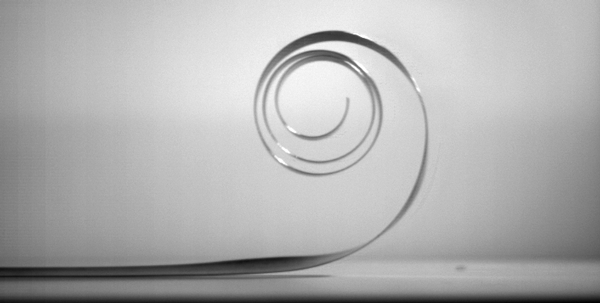Curling Physics Unraveled
Researchers know why ribbons and hairs curl, but few have examined the dynamics of an object going from straight to curled up. A study in Physical Review Letters looks at the simple case of a curved metal strip that is straightened and then released. Using a combination of experiments, numerical simulations, and mathematical analysis, the research team has performed a complete study on the shape and speed of the strip as it curls. The work provides a basic framework for explaining curling in future micromachines or in the splitting open of a red blood cell.
If you twist a rod or pluck on a string, the restoring force is like that of a spring—it’s proportional to the displacement, meaning the farther you pull the object, the stronger the force pulling back. But the curling of a plant tendril or the unfurling of a whip is much harder to analyze because the forces are no longer proportional to a spatial coordinate. Only a few of these nonlinear dynamics problems have been solved [1], and understanding curling would be useful for several fields. Engineers are developing paper-thin films that curl in response to light or temperature changes and therefore could be used as actuators in small robotic devices. In biology, researchers would like to understand how red blood cells curl open when infected by malaria parasites [2].
Andrew Callan-Jones of University of Montpellier II in France and his colleagues decided to study a very simple case of curling, in which a naturally curved strip is held straight and then one end is released. The team neglected air resistance and gravity and focused on the internal elastic forces that try to pull the strip back into its initial curved shape. Their first experiment involved a steel strip that was millimeters thick and meters long. The strip’s natural curvature radius was millimeters. After pulling it flat and releasing it, the team recorded the motion with high speed photography. They saw that during the motion, the strip curled into a consistent structure, with an outer spiral leading into a tight inner “spool” that ended with one last smaller curl. Surprisingly, the radius of the spool was roughly twice that of the steel strip’s natural radius of curvature.
To understand this curling shape, the team performed numerical simulations, which allowed them to see what happens later in the process when the strip has formed more loops than they could generate in experiments. At these late times, they expected the shape and size to remain fixed in time because they thought the strip would roll up into the tight spool section, which would barely influence the diameter. Instead they found that some of the coiling strip adds to the outer, more open, spiral section, so the curl grows in time but keeps its shape, following a so-called self-similar time evolution. This growth raises the height of the curl’s center of mass. Relating this vertical acceleration to the upward force exerted by the flat surface, the team was able to show analytically that the curl grows in size at a rate proportional to time to the power.
The speed at which the strip pulls off the surface could also be analytically derived, by energy conservation. Essentially, each segment of the strip has the same amount of elastic potential energy (when laid flat), so each segment gets the same kick in kinetic energy as the strip rolls up. And therefore the speed of the advancing curl is constant in time. The team solved for this constant speed by relating it to the speed at which the spool rotates. This rotation leads to a centrifugal force that pushes outward on the spool and explains the large radius that was observed in experiments. Combining these various relationships, the authors derived a curling speed of meters per second, which agreed with their observations.
“The authors do an outstanding job in combining experimental, numerical, and analytical results to develop a complete understanding of the problem,” says Alain Goriely of the University of Oxford in England. He thinks this work may motivate more researchers to look at the dynamics of filamentary structures such as DNA and nanotubes. Dominic Vella, also from Oxford, found it interesting that a self-similar solution was required. “While these types of solutions are common in fluid mechanics, it is much rarer to find them in the description of moving elastic objects, and that is what is so nice about this work,” Vella says.
–Michael Schirber
Michael Schirber is a Corresponding Editor for Physics Magazine based in Lyon, France.
References
- A. Goriely and Tyler McMillen, “Shape of a Cracking Whip,” Phys. Rev. Lett. 88, 244301 (2002)
- M. Abkarian, G. Massiera, L. Berry, M. Roques, and C. Braun-Breton, “A Novel Mechanism for Egress of Malarial Parasites from Red Blood Cells,” Blood 117, 4118 (2011)





